
Ginbura Hyakunen
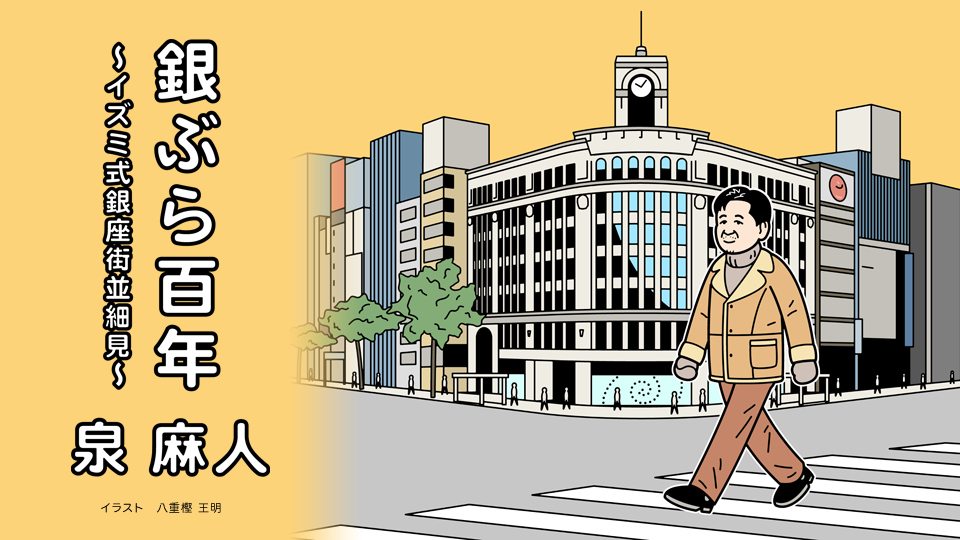
Ginza×銀ぶら百年 Vol.19
銀ぶら百年 ~イズミ式銀座街並細見~
A visit Kyobunkwan with a sacred feeling
2018.12.25
Until very recently, I had believed that Wako was the only building standing on Ginza’s main street (Ginza-dori) from before World War II. However, Kyobunkwan Seishokan (Bible Building), standing on the northern corner of the same 4-chome intersection is also a classical piece of architecture completed in 1933 (Showa 8). The long history of the building is difficult to notice, given its refurbished façade, but when one walks through the magazine corner on the first floor to the the elevator hall on the west side of the building and goes up the stairs, hints of the early Showa period can be found in the railing and window frames. (An antique box for storing the fire extinguishing hose was also installed on the wall of the stairs leading to the basement floor, as was brought to my attention when I visited the building for an interview.)
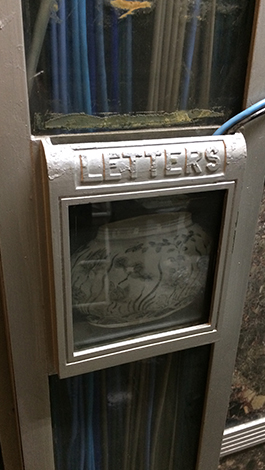
Classical mail chute
I had always hoped to write about the history of the Kyobunkwan bookstore one day, and I was granted the opportunity to interview the current president, Mr. Mitsuru Watabe, in person.
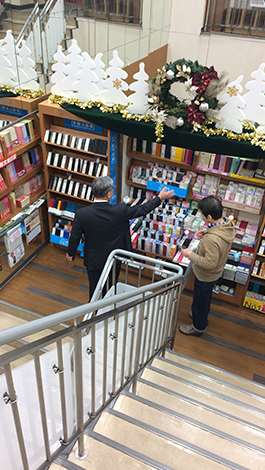
The staircase is used as the entrance
I was taken to a spacious meeting room in the back of the editing room on the seventh floor. Based on my knowledge that Kyobunkwan was a Christian bookstore, I curiously looked around the room in search of a sacred alter with a cross, but could only find paintings on the wall. Then, just when we were about to start the interview, a bell rang. For a moment, I imagined chapel bells ringing somewhere in the Kyobunkwan building, but President Watabe laughed, saying,
“Ah no. This is the three o’clock chime ringing in the Wako clock tower.”
The history of Kyobunkwan dates back to when the Methodist church began missionary activities after the lifting of the ban on Christianity in 1973 (Meiji 6).
“In 1885 (Meiji 18), at a church that used to stand on 11 Tsukiji Kyoryuchi, a decision was made that they would fully launch activities to publish and sell bibles and tracts. The decision was made on September 9, which could be referred to as Kyobunkwan’s birthday.” The church in Tsukiji is the origin of the Ginza Church, which is located on the corner of Sotobori-dori, walking westward on the street running on the side of Kyobunkwan building.
By the way, a tract is a brief brochure that summarizes and communicates the church’s doctrine. Back then, Methodists were called “Me” in Japan, taking the first two letters of their name and written out as “美以(美)” in kanji characters. In the Kanto region, they had originally run a store in Yokohama, but the office and store was eventually moved to Ginza. They were first located in 7-chome, then Takekawa-cho, and in 1893 (Meiji 26) moved to 3-chome where the Saegusa Building (Apple Store) stands today. Two years later, they relocated to 4-chome. It was in 1906 (Meiji 39) that they moved from near Wako to the northern corner, where they stand today.
“The Kyobunkwan Building, a four-story brick building, stood out as an attractive building even amid the glitz and glamour of Ginza in those days. […] We had around twenty employees who attended customers in the store in kimonos, wearing a ‘kakuobi’ belt and apron. They were devoted to selling foreign books and missionary literature…”
The description can be found in the corporate history booklet (Kyobunkwan monogatari: Meiji, Taisho, Showa, Heisei no 130-nen (The story of Kyobunkwan: 130 years through the Meiji, Taisho, Showa and Heisei period) compiled by President Watabe himself. The booklet introduces a unique sales operation launched in the Taisho period which involved becoming Victor Record’s local representative. Furthermore, Kyobunkwan was initially asked to become the sales agent for Omi Kyodaisha (Omi Brotherhood)’s “Mentholatum,” though in vain. Now that I think about it, I recall seeing a large Victor Records ad on the roof of the building until very recently, and a Mentholatum signboard can be seen in a photograph of the building taken from outside in around 1955. Therefore, I would suppose that their relationship had continued over quite a long period of time.
Another episode from the Taisho period is welcoming Hanako Muraoka, an author of children’s books who was also spotlighted in NHK’s morning drama series, as an employee. Having studied at Toyo Eiwa Jogakuin, she published her first book, Rohen from Kyobunkwan’s predecessor, the Christian Literature Society of Japan, and two years later, she started working in the editorial section for Shokoshi, a magazine for children that the Society published. Around then, she met Keizo Muraoka, who worked at Fukuin Printing Co., located behind Kyobunkwan, and later married him. (Keizo’s father owned Fukuin Printing Co.)
Four years after Hanako found a happy end to her “love in Ginza,” the Great Kanto Earthquake burned down the beautiful four-story Kyobunkwan Building. By the end of the year, store was back in business in a two-story barrack and held a Christmas sale.
Fuji Ice, which Ginza’s history cannot be told without mentioning, was also on the second floor of the post-earthquake barrack. It is a place that many writers have written about in their novels and essays.
Fuji Ice continued to run their restaurant on the first and basement floors of the current building that was built in 1933 (Showa 8). Shinsai fukko no machinami kara (From the cityscape of “Great Ginza” after the earthquake), a collection of photos of classical buildings in Ginza that is in my possession, contains a photo of a stylish restaurant at the bottom of a marble spiral staircase winding down from the first floor.
I first found Fuji Ice’s intriguing name in Danchotei nichijo, Kafu Nagai’s diary. It appears frequently from around 1937 (Showa 12). Kafu was obviously fond of the basement floor.
Waiting for the sun to set, had dinner in Ginza and took a break in Fuji’s basement. (April 30)
Met my friends in Ginza in the evening, in the basement of Fuji, and went to the festival at Karasumori Inari Shrine (May 11)
Had dinner at Fuji Ice in Ginza. (September 13)
Kafu uses different kanji characters for “Fuji,” but he tends to play with characters so they unmistakably point to the same store. Despite the word “ice” in the name, it seems to be that Kafu enjoyed meals at Fuji Ice.
In Nihon kindai kenchiku no chichi Antonin Raymond wo shittemasuka (Do you know Antonin Raymond, father of modern Japanese architecture?), another 130th anniversary booklet that Mr. Watabe gave me along with the abovementioned Kyobunkwan monogatari, I found a small picture of Fuji Ice’s menu. Reading it through a magnifying glass, I could identify “Hamburg steak, grilled chicken, oyster fritters, combination salad…” There were almost fifty items on the menu, followed by a “Soda Fountain” section that listed drinks and ice cream. I would imagine that it was a full-service restaurant.
As implied in the title of this booklet, the new 1933 building was designed by the architect, Antonin Raymond, famous for church architecture, such as Saint Paul’s Catholic Church in Karuizawa. (Surprisingly, the last reconstruction of Matsuzakaya Ginza, which was built in 1964 and stood in Ginza until a few years ago, had been the works of Raymond.) The symbolic steeples (which had soared on the Ginza-dori side of the building and on the Seishokan Building in the back) disappeared in around 1955, when the rooftop ad was installed. Speaking of ads, in a corner of the meeting room where this interview took place was a miniature model of Kyobunkwan Building made by students of Osaki High School based on a photograph taken outside of the building in 1961 (Showa 39), when the Tokyo Olympic Games were held. The model not only had a Victor Records ad on the rooftop but also had a large “Maeda no cracker” ad covering the wall facing Wako. It reminded me of the days when the slogan, “Atari Maeda no cracker” (advertised by Makoto Fujita in the TV program “Tenamonya Sandogasa”) was very popular. I was also impressed by the fact that the surrounding buildings were low enough that an ad on the outer wall of the building would actually be noticed by people.
The Showa days ended, followed by the Heisei period, which is about to close its thirty-year history. I recall how in the dawn of the Heisei period, when the bubble economy was at its peak, Kyobunkwan sold magazines in the store entrance. They often had Hanako, a women’s magazine that frequently ran special articles covering Ginza, stacked up. Yamato Shiine, the founding editor of the magazine, humorously wrote in his book, Ginza Hanako monogatari (The Ginza Hanako Story) (Magazine House), about Mr. Yoshiharu Nakamura, then President of Kyobunkwan who was devoted to personally selling books at the store.
“He brought out a table (booth) on the sidewalk in front of the store and stacked up the latest issue of Hanako, along with back issues, and started to call in customers himself. […] Nakamura’s sales booth strategy proved to be a spectacular success and sold record numbers. The 55th issue (June 6, 1989), a special issue covering Ginza, sold more than 30,000 at the booth in Ginza alone. Sales of 30,000 copies of an issue of a weekly magazine at a single store would surely constitute a Guinness world record. Kyobunkwan, alone, sold an average of 2,451 copies of each issue of Hanako from its premiere issue to the No. 150, or over three years.”
Today, thirty years later, the story sounds like a fantasy. It was also this unique president, Mr, Nakamura, who created the “Kingdom of Narnia,” the children’s books floor that Kyobunkwan is most known for today, and “Ein Karem,” the shop on the fourth floor.
Narnia has become even more popular with the success of the movie in the 2000s. Entering the area, I found a bookshelf with children’s books just as I remembered them from my childhood, in almost the same binding and size, beginning with The Lion, the Witch and the Wardrobe (translated by Teiji Seta), the first book of the “The Chronicles of Narnia,” which was first published from Iwanami Shoten when I was in elementary school, followed by the “Doctor Dolittle” series, Iyaiyaen from Fukuinkan Shoten Publishers and My Father’s Dragon. I felt as if I had slipped through time into the library at my elementary school.
“Ah no. This is the three o’clock chime ringing in the Wako clock tower.”
The history of Kyobunkwan dates back to when the Methodist church began missionary activities after the lifting of the ban on Christianity in 1973 (Meiji 6).
“In 1885 (Meiji 18), at a church that used to stand on 11 Tsukiji Kyoryuchi, a decision was made that they would fully launch activities to publish and sell bibles and tracts. The decision was made on September 9, which could be referred to as Kyobunkwan’s birthday.” The church in Tsukiji is the origin of the Ginza Church, which is located on the corner of Sotobori-dori, walking westward on the street running on the side of Kyobunkwan building.
By the way, a tract is a brief brochure that summarizes and communicates the church’s doctrine. Back then, Methodists were called “Me” in Japan, taking the first two letters of their name and written out as “美以(美)” in kanji characters. In the Kanto region, they had originally run a store in Yokohama, but the office and store was eventually moved to Ginza. They were first located in 7-chome, then Takekawa-cho, and in 1893 (Meiji 26) moved to 3-chome where the Saegusa Building (Apple Store) stands today. Two years later, they relocated to 4-chome. It was in 1906 (Meiji 39) that they moved from near Wako to the northern corner, where they stand today.
“The Kyobunkwan Building, a four-story brick building, stood out as an attractive building even amid the glitz and glamour of Ginza in those days. […] We had around twenty employees who attended customers in the store in kimonos, wearing a ‘kakuobi’ belt and apron. They were devoted to selling foreign books and missionary literature…”
The description can be found in the corporate history booklet (Kyobunkwan monogatari: Meiji, Taisho, Showa, Heisei no 130-nen (The story of Kyobunkwan: 130 years through the Meiji, Taisho, Showa and Heisei period) compiled by President Watabe himself. The booklet introduces a unique sales operation launched in the Taisho period which involved becoming Victor Record’s local representative. Furthermore, Kyobunkwan was initially asked to become the sales agent for Omi Kyodaisha (Omi Brotherhood)’s “Mentholatum,” though in vain. Now that I think about it, I recall seeing a large Victor Records ad on the roof of the building until very recently, and a Mentholatum signboard can be seen in a photograph of the building taken from outside in around 1955. Therefore, I would suppose that their relationship had continued over quite a long period of time.
Another episode from the Taisho period is welcoming Hanako Muraoka, an author of children’s books who was also spotlighted in NHK’s morning drama series, as an employee. Having studied at Toyo Eiwa Jogakuin, she published her first book, Rohen from Kyobunkwan’s predecessor, the Christian Literature Society of Japan, and two years later, she started working in the editorial section for Shokoshi, a magazine for children that the Society published. Around then, she met Keizo Muraoka, who worked at Fukuin Printing Co., located behind Kyobunkwan, and later married him. (Keizo’s father owned Fukuin Printing Co.)
Four years after Hanako found a happy end to her “love in Ginza,” the Great Kanto Earthquake burned down the beautiful four-story Kyobunkwan Building. By the end of the year, store was back in business in a two-story barrack and held a Christmas sale.
Fuji Ice, which Ginza’s history cannot be told without mentioning, was also on the second floor of the post-earthquake barrack. It is a place that many writers have written about in their novels and essays.
Fuji Ice continued to run their restaurant on the first and basement floors of the current building that was built in 1933 (Showa 8). Shinsai fukko
I first found Fuji Ice’s intriguing name in Danchotei nichijo, Kafu Nagai’s diary. It appears frequently from around 1937 (Showa 12). Kafu was obviously fond of the basement floor.
Waiting for the sun to set, had dinner in Ginza and took a break in Fuji’s basement. (April 30)
Met my friends in Ginza in the evening, in the basement of Fuji, and went to the festival at Karasumori Inari Shrine (May 11)
Had dinner at Fuji Ice in Ginza. (September 13)
Kafu uses different kanji characters for “Fuji,” but he tends to play with characters so they unmistakably point to the same store. Despite the word “ice” in the name, it seems to be that Kafu enjoyed meals at Fuji Ice.
In Nihon kindai kenchiku no chichi Antonin Raymond wo shittemasuka (Do you know Antonin Raymond, father of modern Japanese architecture?), another 130th anniversary booklet that Mr. Watabe gave me along with the abovementioned Kyobunkwan monogatari, I found a small picture of Fuji Ice’s menu. Reading it through a magnifying glass, I could identify “Hamburg steak, grilled chicken, oyster fritters, combination salad…” There were almost fifty items on the menu, followed by a “Soda Fountain” section that listed drinks and ice cream. I would imagine that it was a full-service restaurant.
As implied in the title of this booklet, the new 1933 building was designed by the architect, Antonin Raymond, famous for church architecture, such as Saint Paul’s Catholic Church in Karuizawa. (Surprisingly, the last reconstruction of Matsuzakaya Ginza, which was built in 1964 and stood in Ginza until a few years ago, had been the works of Raymond.) The symbolic steeples (which had soared on the Ginza-dori side of the building and on the Seishokan Building in the back) disappeared in around 1955, when the rooftop ad was installed. Speaking of ads, in a corner of the meeting room where this interview took place was a miniature model of Kyobunkwan Building made by students of Osaki High School based on a photograph taken outside of the building in 1961 (Showa 39), when the Tokyo Olympic Games were held. The model not only had a Victor Records ad on the rooftop but also had a large “Maeda no cracker” ad covering the wall facing Wako. It reminded me of the days when the slogan, “Atari Maeda no cracker” (advertised by Makoto Fujita in the TV program “Tenamonya Sandogasa”) was very popular. I was also impressed by the fact that the surrounding buildings were low enough that an ad on the outer wall of the building would actually be noticed by people.
The Showa days ended, followed by the Heisei period, which is about to close its thirty-year history. I recall how in the dawn of the Heisei period, when the bubble economy was at its peak, Kyobunkwan sold magazines in the store entrance. They often had Hanako, a women’s magazine that frequently ran special articles covering Ginza, stacked up. Yamato Shiine, the founding editor of the magazine, humorously wrote in his book, Ginza Hanako monogatari (The Ginza Hanako Story) (Magazine House), about Mr. Yoshiharu Nakamura, then President of Kyobunkwan who was devoted to personally selling books at the store.
“He brought out a table (booth) on the sidewalk in front of the store and stacked up the latest issue of Hanako, along with back issues, and started to call in customers himself. […] Nakamura’s sales booth strategy proved to be a spectacular success and sold record numbers. The 55th issue (June 6, 1989), a special issue covering Ginza, sold more than 30,000 at the booth in Ginza alone. Sales of 30,000 copies of an issue of a weekly magazine at a single store would surely constitute a Guinness world record. Kyobunkwan, alone, sold an average of 2,451 copies of each issue of Hanako from its premiere issue to the No. 150, or over three years.”
Today, thirty years later, the story sounds like a fantasy. It was also this unique president, Mr, Nakamura, who created the “Kingdom of Narnia,” the children’s books floor that Kyobunkwan is most known for today, and “Ein Karem,” the shop on the fourth floor.
Narnia has become even more popular with the success of the movie in the 2000s. Entering the area, I found a bookshelf with children’s books just as I remembered them from my childhood, in almost the same binding and size, beginning with The Lion, the Witch and the Wardrobe (translated by Teiji Seta), the first book of the “The Chronicles of Narnia,” which was first published from Iwanami Shoten when I was in elementary school, followed by the “Doctor Dolittle” series, Iyaiyaen from Fukuinkan Shoten Publishers and My Father’s Dragon. I felt as if I had slipped through time into the library at my elementary school.
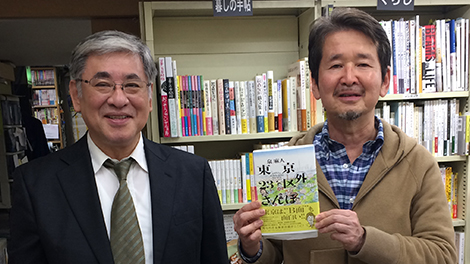
Hurry for an autographed issue!
During this time of year, Ein Karem, on the fourth floor, has Christmas cards lined up from the entrance of the shop. It was nice walking into the store from the classical elevator hall, as it reminded me of a traditional Christmas in Ginza from a while before. Looking for Christmas cards here would be a wonderful way to spend a cold snowy day.
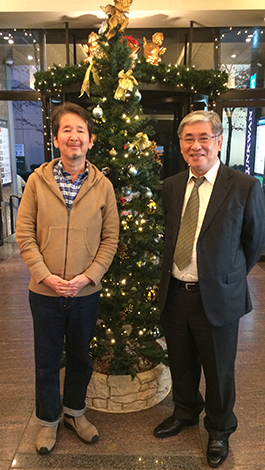
With President Watabe in front of the Christmas tree
All List
- Ginza×銀ぶら百年 Vol.27 Typographer in Kobikicho
- Ginza×銀ぶら百年 Vol.26 The King of Mingei on Nishiginza-dori
- Ginza×銀ぶら百年 Vol.25 To Hachimaki Okada with hopes for the restoration of Ginza
- Ginza×銀ぶら百年 Vol.24 The man who built the San-Ai building
- Ginza×銀ぶら百年 Vol.22 The Centennial of the Ginza Street Association
- Ginza×銀ぶら百年 Vol.21 The continuing strong presence of Echigoya kimono store
- Ginza×銀ぶら百年 Vol.20 The people who created Ginza’s India, “Nair’s” in Higashi-Ginza
- Ginza×銀ぶら百年 Vol.19 A visit Kyobunkwan with a sacred feeling
- Ginza×銀ぶら百年 Vol.18 Nishi Ginza, a new stylish way
- Ginza×銀ぶら百年 Vol.17 Ginza Toraya’s Panama Hat
- Ginza×銀ぶら百年 Vol.16 TEIMEN and the Ginza Ivy Era
- Ginza×銀ぶら百年 Vol.15 Christmas with Peco-chan
- Ginza×銀ぶら百年 Vol.14 It’s summer! Beer! The LION!
- Ginza×銀ぶら百年 Vol.13 The Yoshida Croquette Soba Legend
- Ginza×銀ぶら百年 Vol.12 Sasaki Shoten, retailer of pipes and “Tsuya-fukin”
- Ginza×銀ぶら百年 Vol.11 Memories of Gekkoso and Dried Sardines
- Ginza×銀ぶら百年 Vol.10 A visit to Taimei Elementary School, king of elementary schools
- Ginza×銀ぶら百年 Vol.09 A Senbei Store in Ginza
- Ginza×銀ぶら百年 Vol.08 Advertisements of Ginza in 1911 (Meiji 44)
- Ginza×銀ぶら百年 Vol.07 The mysteries of a legendary panoramic building, TENKADO
- Ginza×銀ぶら百年 Vol.06 A History Lesson at SAEGUSA
- Ginza×銀ぶら百年 Vol.05 The secrent behind the deep-fried chicken served at Mikasa Kaikan
- Ginza×銀ぶら百年 Vol.04 Yamano Music in summer 1971
- Ginza×銀ぶら百年 Vol.03 The Ginza Apartments in Ginza 1-chome
- Ginza×銀ぶら百年 Vol.02 Memories of Olympic
- Ginza×銀ぶら百年 Vol.01 Visiting ITOYA at year’s end








